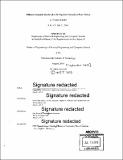Efficient semantic retrieval on K-segment coresets of user videos
Author(s)
Kandel, Pramod
DownloadFull printable version (10.43Mb)
Other Contributors
Massachusetts Institute of Technology. Department of Electrical Engineering and Computer Science.
Advisor
Daniela Rus and Guy Rosman.
Terms of use
Metadata
Show full item recordAbstract
Every day, we collect and store various kinds of data with our modern sensors, phones, cameras, and various gadgets. One of the richest available data is video data. We take numerous hours of videos with our phones and cameras, and store them in computers or cloud. However, because recording videos produce large files, it is hard to search and locate for specific video segments within a video library. We might need the part where "Matt was playing guitar", or we might want to see "the glimpse of John's laptop" among hours of video data that contain those pieces. The goal of this thesis is to create a system that is able to retrieve efficiently the relevant segments(frames) in the video by allowing users to do textual search based on objects of the video, such as "guitar" or "laptop". A big challenge with videos is the huge space required to store them, therefore making it difficult to retrieve and analyze videos. This thesis presents an efficient compression method, which uses k-segment mean coresets to represent the video data using fewer frames while preserving the information content in the original data set. The system then uses a state-of-the-art object detector to analyze and detect objects in the reduced data. The objects and corresponding frames are stored and cross-linked to the original data to enable retrieval. The system allows users to pose text queries about objects in the videos. It is important that the retrieval of the stored objects is as efficient and meaningful as possible. This thesis presents a retrieval algorithm, also based on the k-segment mean coreset algorithm, which allows efficient any-time retrieval of the detected objects, retrieving the "more preferred" or "more important" frames earlier. The system presents the any-time results to the users in an incremental way. This thesis describes the architecture and modules of the objects retrieval system for video data. The modules include the user interface for making the search query and displaying the results, the module for video compression with coresets, the object-detection module, the retrieval module, and the data flow between them. This thesis describes an implementation of this system, the algorithms used, and a suite of experiments to validate and evaluate the algorithms. The results show that using coresets, it is possible to identify, store, and efficiently retrieve video segments by specifying the objects in video data.
Description
Thesis: M. Eng., Massachusetts Institute of Technology, Department of Electrical Engineering and Computer Science, September 2015. "August 2015." Cataloged from PDF version of thesis. Includes bibliographical references (pages 102-107).
Date issued
2015Department
Massachusetts Institute of Technology. Department of Electrical Engineering and Computer SciencePublisher
Massachusetts Institute of Technology
Keywords
Electrical Engineering and Computer Science.